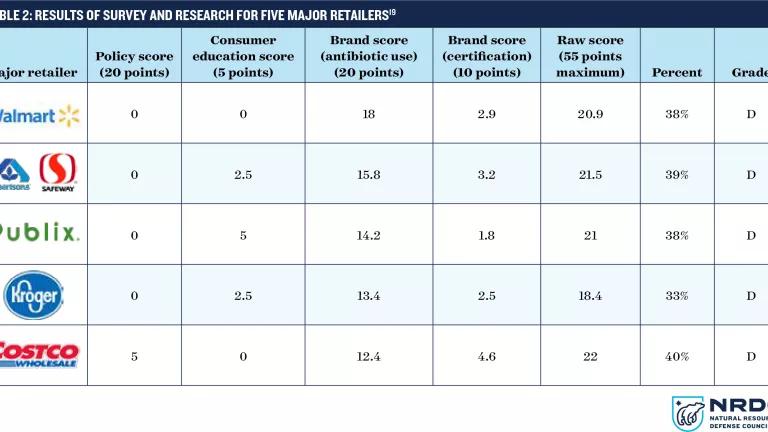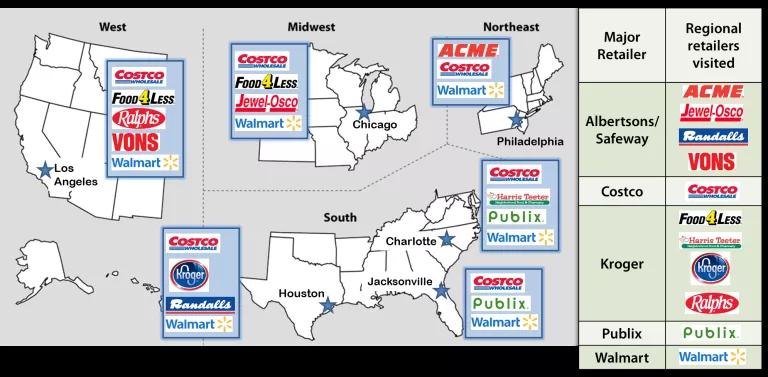Top Grocery Stores Are Lagging on Antibiotics in Chicken

With our nation facing a growing crisis of antibiotic-resistant infections, leading health organizations have been calling for not only for a reduction in the amount of unnecessary antibiotics used in human medicine, but also in animal agriculture. That’s because more than 70 percent of drugs that are deemed “medically important” for use in humans by the U.S. Food and Drug Administration are actually used on livestock, often on animals that are not sick. Experts warn that ending this overuse of antibiotics is a key step in keeping them working when sick people need them.
While federal progress to address the problem has stalled, dramatic shifts in consumer demand have created strong market pressure for phasing out routine use of antibiotics in chicken in recent years. Top fast food restaurants and chicken producers are increasingly responding to demand for meat raised with fewer antibiotics. In contrast, major grocery store chains—which provide chicken served at millions of dinner tables across the country—have remained noticeably quiet.
A new report out today from NRDC investigates the manner in which the five major grocery store chains in North America—representing more than 50 percent of the market share—market and sell chicken brands from producers committed to responsible antibiotic use.
The upshot? None of the grocery chains are doing their part to promote responsible antibiotics use in chicken. They all received a “D” grade.
For Crying Fowl: Major Grocers Stumble in Promoting Antibiotic Stewardship in Retail Chicken, in the spring of 2016, NRDC surveyed fresh chicken sold in grocery store aisles in six major metropolitan areas across the country: Philadelphia, Houston, Charlotte, Jacksonville, Los Angeles and Chicago. The report provides a snapshot of the chicken brand choices found on these stores’ shelves, the grocery chains’ public commitments around antibiotic use in their private label brands, if any, and the extent of signage or informational materials in the stores directing consumers to chicken raised without the routine use of antibiotics.
Key findings from our survey of the grocers and their regional store chains (shown in the graphic below) include:
- None of the major grocery chains has publicly committed to eliminating routine antibiotic use in their chicken supply chain.
- Most grocery stores surveyed lacked signage to direct consumers to offerings of RWA or USDA certified organic chicken.
- The proportion of brand choices with verified antibiotic use claims varied widely from grocer to grocer (20 to 50 percent). A significant portion of antibiotic use claims are unverified.
- The small bright spot is that all grocery chains offer at least one brand choice reflecting responsible antibiotic use.

While major chicken producers like Tyson and Perdue—and top fast food chains like McDonald’s, Subway and KFC—have made broad commitments to phase out routine use of antibiotics on chicken, grocery stores have made minimal progress in comparison. Strikingly, grocery store shoppers may not even have enough information to identify and choose chicken from companies that have already made an antibiotics commitment.
The nation’s top grocery store chains can have a major impact on how chicken is raised in the U.S.—for better or worse. They should use their massive market influence to increase the availability of chicken raised without the routine use of antibiotics to shoppers, and to empower consumers to make informed decisions about the chicken they choose on their weekly shopping trips. Grocery store chains have the ability to do this by setting antibiotics use policies, whether storewide for their entire supply chain or for their own private label chicken. Consistent signage in stores can also go a long way in helping consumers find better chicken options. And grocery chains can also work with producers to push for greater verification of antibiotics claims to bolster consumer confidence, and to communicate to consumers about chicken from companies that have made a meaningful commitment to eliminate routine antibiotic use even if the chicken is not USDA Certified Organic or USDA Process Verified Raised without Antibiotics.
Cooking and enjoying dinner at home is a treasured experience for families across the country. Consumers should be able to make good, informed choices about the meat they bring home to their tables. The nation’s top grocery stores should follow the lead of the fast food industry and do their part to protect public health by making chicken raised without antibiotics more available and accessible to their customers.
